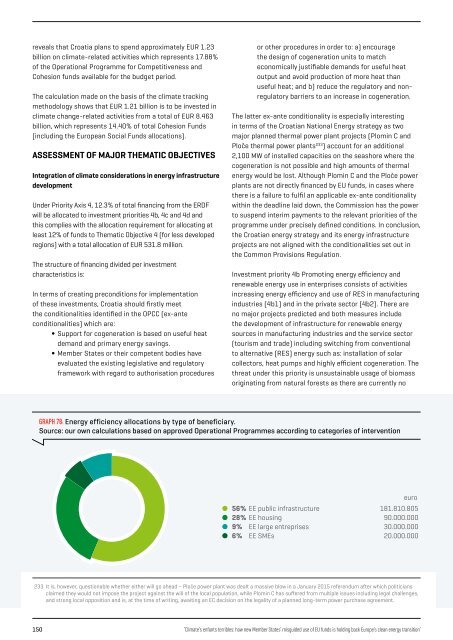ENFANTS TERRIBLES
enfants-terribles
enfants-terribles
Create successful ePaper yourself
Turn your PDF publications into a flip-book with our unique Google optimized e-Paper software.
eveals that Croatia plans to spend approximately EUR 1.23<br />
billion on climate-related activities which represents 17.88%<br />
of the Operational Programme for Competitiveness and<br />
Cohesion funds available for the budget period.<br />
The calculation made on the basis of the climate tracking<br />
methodology shows that EUR 1.21 billion is to be invested in<br />
climate change-related activities from a total of EUR 8.463<br />
billion, which represents 14.40% of total Cohesion Funds<br />
(including the European Social Funds allocations).<br />
ASSESSMENT OF MAJOR THEMATIC OBJECTIVES<br />
Integration of climate considerations in energy infrastructure<br />
development<br />
Under Priority Axis 4, 12.3% of total financing from the ERDF<br />
will be allocated to investment priorities 4b, 4c and 4d and<br />
this complies with the allocation requirement for allocating at<br />
least 12% of funds to Thematic Objective 4 (for less developed<br />
regions) with a total allocation of EUR 531.8 million.<br />
The structure of financing divided per investment<br />
characteristics is:<br />
In terms of creating preconditions for implementation<br />
of these investments, Croatia should firstly meet<br />
the conditionalities identified in the OPCC (ex-ante<br />
conditionalities) which are:<br />
• Support for cogeneration is based on useful heat<br />
demand and primary energy savings.<br />
• Member States or their competent bodies have<br />
evaluated the existing legislative and regulatory<br />
framework with regard to authorisation procedures<br />
or other procedures in order to: a) encourage<br />
the design of cogeneration units to match<br />
economically justifiable demands for useful heat<br />
output and avoid production of more heat than<br />
useful heat; and b) reduce the regulatory and nonregulatory<br />
barriers to an increase in cogeneration.<br />
The latter ex-ante conditionality is especially interesting<br />
in terms of the Croatian National Energy strategy as two<br />
major planned thermal power plant projects (Plomin C and<br />
Ploče thermal power plants 233 ) account for an additional<br />
2,100 MW of installed capacities on the seashore where the<br />
cogeneration is not possible and high amounts of thermal<br />
energy would be lost. Although Plomin C and the Ploče power<br />
plants are not directly financed by EU funds, in cases where<br />
there is a failure to fulfil an applicable ex-ante conditionality<br />
within the deadline laid down, the Commission has the power<br />
to suspend interim payments to the relevant priorities of the<br />
programme under precisely defined conditions. In conclusion,<br />
the Croatian energy strategy and its energy infrastructure<br />
projects are not aligned with the conditionalities set out in<br />
the Common Provisions Regulation.<br />
Investment priority 4b Promoting energy efficiency and<br />
renewable energy use in enterprises consists of activities<br />
increasing energy efficiency and use of RES in manufacturing<br />
industries (4b1) and in the private sector (4b2). There are<br />
no major projects predicted and both measures include<br />
the development of infrastructure for renewable energy<br />
sources in manufacturing industries and the service sector<br />
(tourism and trade) including switching from conventional<br />
to alternative (RES) energy such as: installation of solar<br />
collectors, heat pumps and highly efficient cogeneration. The<br />
threat under this priority is unsustainable usage of biomass<br />
originating from natural forests as there are currently no<br />
GRAPH 78: Energy efficiency allocations by type of beneficiary.<br />
Source: our own calculations based on approved Operational Programmes according to categories of intervention<br />
euro<br />
56% EE public infrastructure 181.810.805<br />
28% EE housing 90.000.000<br />
9% EE large entreprises 30.000.000<br />
6% EE SMEs 20.000.000<br />
233 It is, however, questionable whether either will go ahead – Ploče power plant was dealt a massive blow in a January 2015 referendum after which politicians<br />
claimed they would not impose the project against the will of the local population, while Plomin C has suffered from multiple issues including legal challenges,<br />
and strong local opposition and is, at the time of writing, awaiting an EC decision on the legality of a planned long-term power purchase agreement.<br />
150<br />
‘Climate’s enfants terribles: how new Member States’ misguided use of EU funds is holding back Europe’s clean energy transition’


